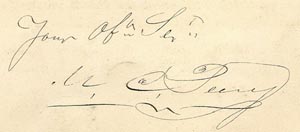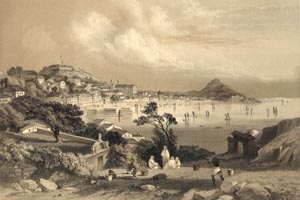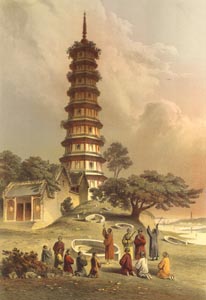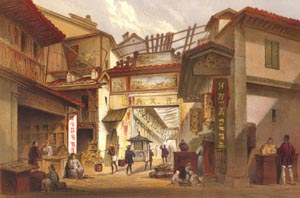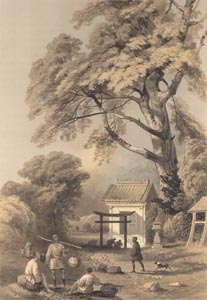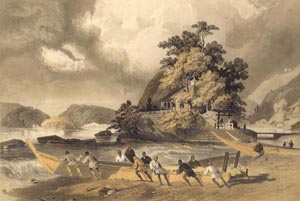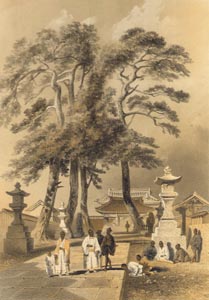Biographical Sketch of Com. M. C. Perry, U. S. N.
It was under the command of the distinguished officer whose portrait forms the appropriate introduction to this work, that Mr. Heine had, as one of the artists of the squadron, the opportunity afforded him of employing his pencil on the expedition to Japan. It seems therefore not unmeet that a brief biographical sketch of Commodore Perry should precede the picture representations, which the artist here offers to the reader's inspection. It must of necessity be short; and the compiler of the incidents of the expedition, submitted by the Commodore to the Government, as his official report, has, at the request of Mr. Heine, endeavored to compress into small compass the principal events of a professional life unusually active and varied. His materials may be relied on as authentic.
Commodore Matthew Calbraith Perry was born in Rhode Island, and entered into navy as a midshipman on the 16th of January, 1809, when be immediately joined the schooner Revenge, from which he was soon after transferred to the frigate President. In November, 1813, he was ordered to the United Slates, and in April, 1814, was sent back to the President. Toward the end of 18I4, he was ordered to the brig Chippewa, from which vessel he was transferred to the Navy Yard at Brooklyn, with the rank of Lieutenant. It will thus be seen that he learned the duties of his profession amid the stirring events of the war of 1812 with Great Britain, when every officer of our little navy was more or less in active service, and it is but justice to say, that as a midshipman and lieutenant, Commodore Perry had his share of dangers and honors. He manifested both intelligence and intrepidity and laid the foundation of his future reputation as an officer in conflicts which called forth the best faculties of able Seamen.
In August, 1819, he was ordered to the ship Cyane, which was sent to the coast of Africa, to aid the efforts of the Colonization Society in its attempt to found a settlement of free blacks upon the island of Sherbro, near Sierra Leone.
Captain Treuchard, who was chief in the expedition, was disabled by sickness during the cruise, so that most of the responsibilities of command, &c., devolved upon Lieut. Perry, and this brought him into direct communication with Mr. Bacon, the resident agent of the Colonization Society, as well us with the native chiefs. The mortality at Sherbro soon proved that a colony could not be plated there, and Mr. Bacon requested Lieut. Perry, during the cruise of the Cyane to the southward, to look for a better site. When the ship reached Mesurado Cape, the Lieutenant, at once appreciating its advantages, selected it as a suitable locality for a town, and opening negotiations with the neighboring chiefs and head men, ascertained that the cape and as much land as was needed could be purchased, and he secured a promise from the natives of aid and friendship to the settlers. The locality of the first settlement of Liberia therefore was suggested by Commodore Perry.
The Cyane, while on the African coast, captured numerous slavers, and on her return to the United Stales, Lieut. Perry communicated to the Colonization Society all the information he had collected, and was ordered by the Navy Department to return immediately to the coast of Africa, in the Alligator, and superintend the removal of the colonists from Sherbro to the new site he had selected at Cape Mesurado. His health, however, had been so much affected by the climate that he was excused for a short time, and Lieut. Stockton took his place and performed the allotted duty.
In May, 1821, Commodore Perry was honored with his first command, having then been ordered, to the schooner Shark, as Lieutenant In this vessel he twice visited the colony at Mesurado, and gave every aid and encouragement he could to its advancement and prosperity. But beside his cruises in this vessel to the African coast, it was in her also that he scoured the West India waters in the successful pursuit of the pirates who then infested them, making several captures.
On the termination of his command in this vessel, he was again attached to the Navy Yard at Now York, where he remained until 1824, when he was ordered to the North Carolina of 96 guns, under the command of Commodore John Rogers. In this ship he served, during the entire cruise, as First Lieutenant and Captain of the Fleet. During her absence, he was appointed a commander, and immediately on her return home, was ordered to the command of the recruiting service at Boston. In this position he acted until 1830, when the now corvette Concord was put in commission, and he was directed to take the command of her and convey the Late Honorable John Randolph as United States Minister to St. Petersburg, Russia, after which he made a cruise of nearly three years in the Mediterranean.
On his return, Commander Perry was once more ordered to the New York Yard, where he was successively employed as second in command, a superintendent of a school of gun practice, and in the organization of a naval steam-service, just then coming under the notice of the Government. During this last employment he was promoted to the rank of captain, and was offered the command of the Antartic exploring expedition, which was afterward given to Commander Wilkes. This offer was declined by Capt. Perry, because he was reluctant to leave the important duty in which he was then engaged of introducing steamers into the navy, and because also he believed the vessels then assigned for the severe service of Antartic navigation to be unfitted for the purpose.
In 1838, Capt. Perry was sent to Europe to visit the dock-yards and light-houses, and collect from personal inspection such facts as might be useful in improving those departments of the service among ourselves; his mission also included attention to gunnery and the construction of war steamers. On his return, early in 1839, he submitted his report to the Government, and resumed his duties as superintendent of gun practice, and in preparing plans for the construction and equipment of the Missouri and the Mississippi, the first two ocean steamers in our navy. To the construction of the former, he gave his immediate personal attention.
While thus employed, Capt. Perry was, in opposition to his own wishes, appointed to the chief command of the Now York Navy Yard and Station, where he continued for two years, when, at his own request, he was released from its duties, and appointed immediately to the command of the African squadron, sent out under the provisions of the treaty with England, negotiated by Mr. Webster and Lord Ashburton. He had special instructions on this mission to establish depots and agencies on the African coast, as also sanitary regulations for that insalubrious station, and was directed to organise a system of mutual and friendly co-operation with the British authorities and naval officers in carrying out the provisions of the treaty. He succeeded so well in accomplishing this latter object that he received not only the approbation of his own Government, but his conduct called forth a commendation from the British minister. On this visit to Africa, he was obliged to punish several of the native tribes for acts of piracy and murder committed upon Americans, and by a train of measures severely just, and yet comparatively lenient, succeeded in establishing with these wild barbarians a compact for future friendly intercourse.
On the return of Commodore Perry from Africa, he was employed in various special duties until the war commenced with Mexico, when most unexpectedly, and without application from any source, Mr. Bancroft, Secretary of the Navy, offered him the command of the naval forces in the Gulf of Mexico, to relieve Commodore Conner, whose period of command was about expiring, and whose health was precarious. Commodore Conner, however, desiring to remain somewhat longer, Commodore Perry was sent out as second in command, with the understanding that after no great interval he was to assume the command in chief. This he did in March, 1847, just before the bombardment of Vera Cruz; and jointly with General Scott, he subscribed the terms of capitulation of that city and castle to the combined military and naval forces of the United Stales. He continued to conduct all the naval operations in the Gulf until the close of the war, controlling and conducting for a considerable time the municipal affairs of all the ports upon the coast, except Vara Cruz and Tampico, which were under the joint government of the army and navy. He held also Yucatan in a state of forced quietude.
About the time he returned from Mexico, the law was passed establishing U.S. mail steamers, and the then Secretary of the Navy, Mr. Mason, appointed Commodore Perry superintendent of those connected with the navy department; and while thus employed he occupied himself also in collecting information and making representations to the Government which resulted in the equipment of the expedition to Japan, the history of which is now public.
By reference to the records of the navy department, and to he navy register, we believe it will be found that Commodore Perry, though comparing favorably in age with his contemporaries, has seen more actual service in ships of war at sea, and has had, in the aggregate, a greater number of vessels and a larger number of officers under his command, than any other officer now or at any time in the American navy since its organization in 1799. We are happy to add, that should his country need him, he is hale and strong, and as able as he ever was to serve her.

